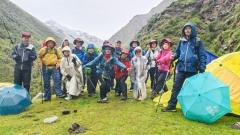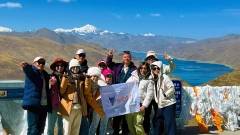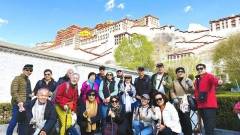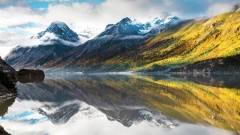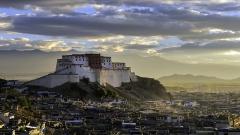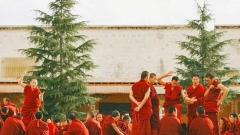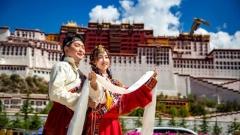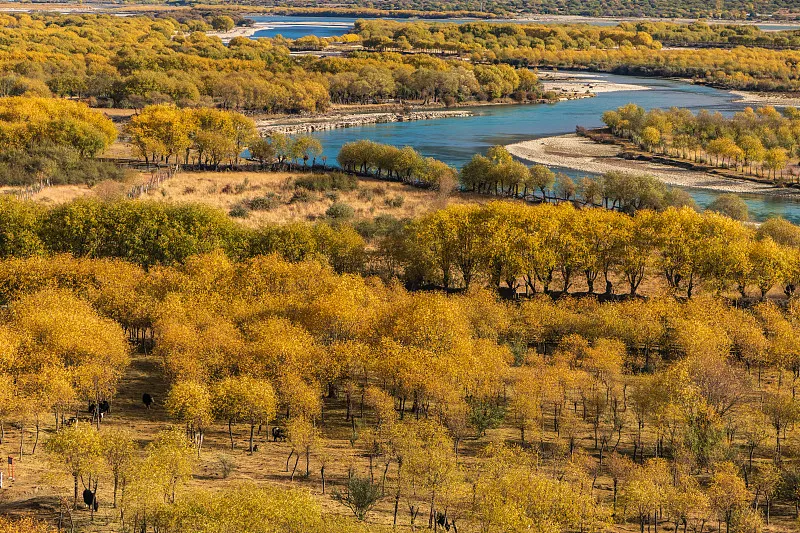Nothing prepares you for the first time you step onto the shore of Namtso Lake. Known in Tibetan as Namtso (Nàmù Cuò), literally “Heavenly Lake,” Namtso is one of Tibet’s most sacred and photogenic destinations. The sky seems deeper here, the air thinner and clearer, and the water a turquoise so luminous it looks unreal — like a perfect mirror laid at the feet of snow-capped mountains.
Namtso basic facts at a glance
- Name: Namtso (Tibetan), Nàmù Cuò (Chinese) — “Heavenly Lake”
- Altitude: 4,718 m (15,479 ft). A truly high-altitude destination.
- Area & scale: Roughly 1,900–1,920 km², with long shorelines and several islands; it ranks among the largest salt lakes on the Tibetan Plateau.
- Depth: Average depth tens of metres with reported maximums exceeding 100 m in places.
- Location: Northwest of Damxung County / north of Lhasa (approx. 250 km by road).
- Accessibility: No regular public bus service — visitors typically go by private car, rental or organised tour vehicle.
- Best season: Late spring through autumn (May–October) for open water, clearer skies and accessible roads.
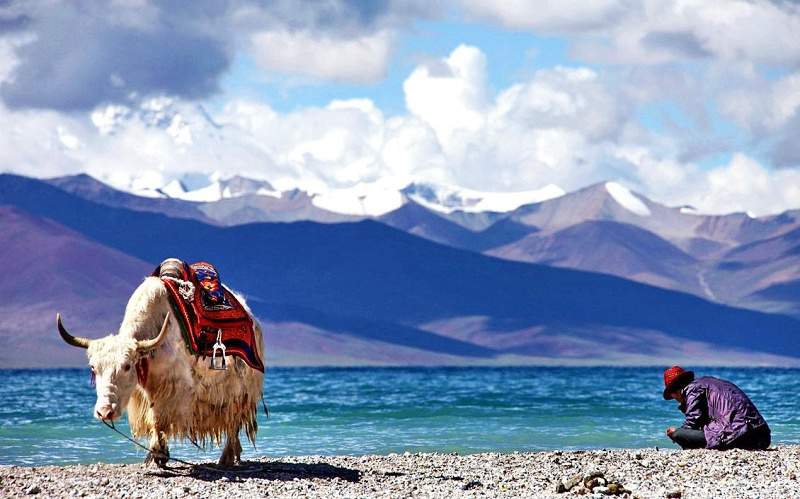
Namtso Lake
Why visit Namtso?
Namtso is a destination of contrasts: holy and wild; intimate and vast. Pilgrims have circumambulated its shores for centuries; nomads graze yaks on the lakeside grasslands; photographers chase reflections, sunrise and sunset colours; and trekkers and day-trippers marvel at the snowline of the Nyenchen Tanglha (Nyainqêntanglha) range that frames the lake to the south. The combination of spiritual culture, dramatic light, and the sheer sense of space is unlike anywhere else on earth.
Best time to visit Namtso
- May–October: Roads are generally open, ice melts and the lake shows its full turquoise colours. Summer offers longer daylight and clearer views of the mountains.
- Late autumn to early spring: Expect freezing conditions — parts of the lake freeze over in winter. If you like stark, snowy landscapes and frozen lakes, winter has its own appeal, but travel is harder and services sparse.
Spiritual and cultural highlights
- Kora around the lake: Pilgrims walk clockwise around sacred lakes and mountain bases to earn merit. The lake kora at Namtso is a deeply spiritual experience — quiet, meditative and often accompanied by rhythmic chanting and spinning prayer wheels. Respect pilgrims’ space and photography preferences.
- Mani mounds and carved stones: Along the shore you’ll find piles of inscribed stones with six-syllable mantras and carved deity images — a constant reminder of the lake’s religious significance.
- Tibetan hermitages and caves: The Nyenchen Tanglha foothills have ancient hermit caves and retreat sites — some are visible from the lake and some have footpaths leading to them.
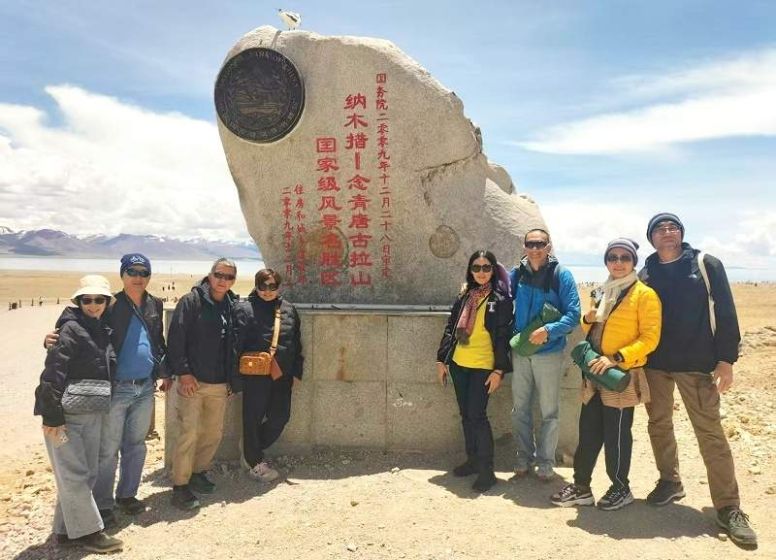
Practical transport info of Namtso
There is no regular public bus to Namtso. Most visitors travel from Lhasa by private hire or organised tour vehicle. The drive is roughly 240–260 km and typically takes 4–6 hours depending on stops, road conditions and traffic checks. Expect long stretches of open plateau road, with stunning vistas and occasional stops for photos or brief hikes.
Tips:
- Hire a private car if you want a flexible stop schedule (photo stops, short hikes).
- Join a small group tour or use a local operator — they handle permits, logistics and tickets. (See the Practicalities section below.)
- Always check road closures in winter or early spring: mountain passes can be closed after snow.
Namtso Tickets and opening hours
Namtso lies within a managed scenic area and there is an entrance procedure: conventional opening hours and a ticket fee apply during the tourist season. Ticket prices, hours and enforcement can vary by year and operator; in recent years fees around ¥120 (high season) / ¥60 (off season) and typical opening windows of 09:00–18:00 have been seen — but your Tibetan guide or operator will handle ticket purchase and the most current rules for you.
Note: In recent years the area around Namtso has been included in a broader protected area / national park management plan, which affects infrastructure, access and permitted activities. Confirm details with your tour operator before departure.
What to expect after arriving at Namtso Lake?
Approaching Namtso is cinematic: a blue expanse appears, then mountains, then long arcing beaches. There are a few concentrated visitor areas (like Tashi Dor at the southeast corner, with a small monastery and prayer flags), but much of the shoreline is wild and empty. You’ll see mani (prayer) stone piles, prayer flags, and often small groups of pilgrims performing kora (circumambulation). Birdlife inhabits the islands, and in summer the grasslands around the lake are dotted with tents and yak herds.
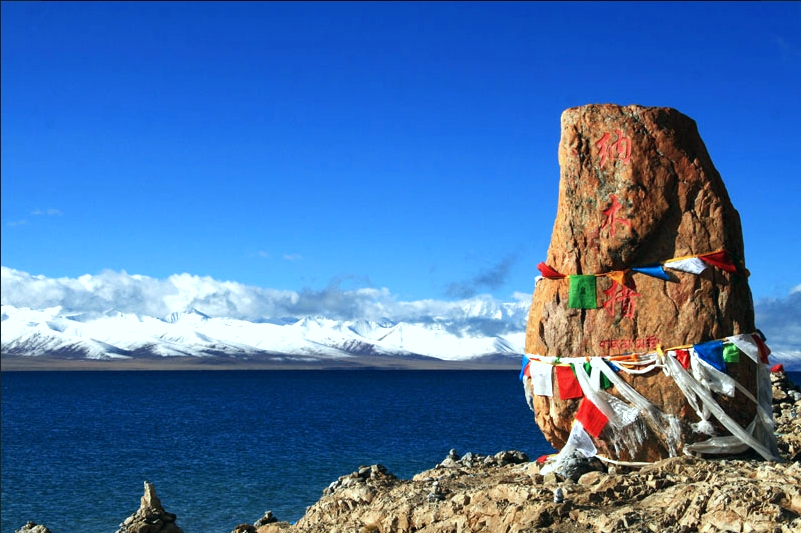
Namtso accommodation: sleep by the lake
Many travellers choose to stay at the lakeshore to watch sunset and sunrise. Options are simple guesthouses, basic mountain lodges or supervised camping. Expect rustic facilities: thin mattresses, shared toilets or squat toilets, basic heating with limited hot water. Bring a warm sleeping bag rated for cold nights if you plan to camp or stay in guesthouses.
Top tip: Book your lakeside stay through a reputable operator who can arrange weather-ready accommodation and emergency plans. In bad weather they can arrange to return you safely to Lhasa.
Suggested Namtso itineraries
Below are sample plans depending on how much time and energy you have.
Day trip from Lhasa (long day)
- Early morning departure from Lhasa (pre-dawn if you want sunrise).
- Drive via Damxung with photo stops.
- Arrive at Tashi Dor or one of the lakeside viewpoints mid-morning. Short walks, mani mound visits, light picnic.
- Return to Lhasa in the evening.
Good for: travellers short on time but accustomed to altitude and long drives.
Overnight lakeside (recommended)
- Day 1: Depart Lhasa, arrive at Namtso by afternoon, set up at guesthouse/camp, golden hour photos.
- Night: Stargazing — the plateau has spectacular night skies.
- Day 2: Sunrise at the shore, explore Tashi Dor, return to Lhasa in the afternoon.
Good for: photography, watching sunrise/sunset, more relaxed pace.
2–3 day trek and kora
- For trekkers who want to explore beyond the road, longer hikes circumvent sections of the lake and explore high pasturelands and hermitages. This requires strong high-altitude fitness and a guide.
Good for: seasoned trekkers, pilgrims seeking a longer kora.
Photography & where to shoot at Namtso
- Golden hour (sunrise and sunset): The low sun makes the lake glow; reflections and cloud formations are dramatic.
- Tashi Dor: Classic compositions with prayer flags and the Nyenchen Tanglha range.
- Islands and bird colonies: Use a long lens for birds; telephoto helps capture distant yaks and island shapes.
- Wide-angle lakeshore shots: Emphasise scale — include a person, mani mound or yak to show vastness.
Packing: wide-angle lens (16–35 mm or similar), telephoto (70–200+ mm), sturdy tripod, polarising filter to reduce glare and deepen the sky.
Namtso altitude: what every traveller must know
Namtso sits at very high altitude. The jump from Lhasa (~3,650 m) to Namtso (~4,718 m) is significant. Follow these guidelines:
- Acclimatise in Lhasa for at least 2 full days (better 3–4) before heading to Namtso.
- Hydrate constantly — drink water regularly; avoid alcohol and heavy exertion in the first 48 hours.
- Know symptoms of acute mountain sickness (headache, nausea, dizziness, shortness of breath) and stop ascending if they appear. Descend immediately if symptoms worsen.
- Carry diamox (acetazolamide) only if prescribed by your physician for altitude prevention; consult your doctor before travel.
- Pack a small medical kit, portable oxygen canisters are available for emergencies but are not a substitute for descent.
- If you have significant cardiopulmonary conditions, discuss travel with a medical professional — high plateau travel can be risky.
What to pack for Namtso trip
- High-altitude clothing layers: thermal base layer, fleece, windproof/waterproof shell.
- Warm hat, gloves, scarf / neck gaiter.
- Good walking boots with ankle support.
- Sunglasses (high UV), sunscreen (SPF 50+), lip balm.
- Warm sleeping bag (if camping), insulated sleeping mat.
- Water bottle, electrolyte powder, snacks (nuts, energy bars).
- First-aid kit and any personal medication.
- Camera gear with spare batteries (batteries drain faster in cold).
- Portable power bank(s) — power access is limited.
- Small cash for local purchases and tips.
Common questions for Namtso Lake
Q: Do I need a permit to visit Namtso?
A: Travel regulations in Tibet can be complex. Most international travellers visit Namtso as part of an organised tour; your operator will manage travel permits and registration. Always confirm permit procedures before travel.
Q: Can I drive myself from Lhasa?
A: Self-drive is possible for experienced drivers used to high-altitude driving and Chinese road rules. Many visitors choose a private hire or tour vehicle for safety and convenience.
Q: Is it safe to swim in Namtso?
A: No — the water is extremely cold and the altitude makes swimming risky. Swimming is not recommended.
Q: Will there be mobile coverage?
A: Coverage is patchy. Expect to have no reliable signal in many lakeside spots; plan accordingly.
Why choose a local tour operator for Namtso?
Because Namtso is remote and high, working with an experienced local operator offers several advantages:
- They handle permits and entrance tickets (no advance online booking is usually necessary; guides purchase on arrival).
- They provide vehicles adapted to plateau driving and local drivers familiar with the route.
- They understand current road conditions, guesthouse standards and emergency procedures — crucial for high-altitude travel.
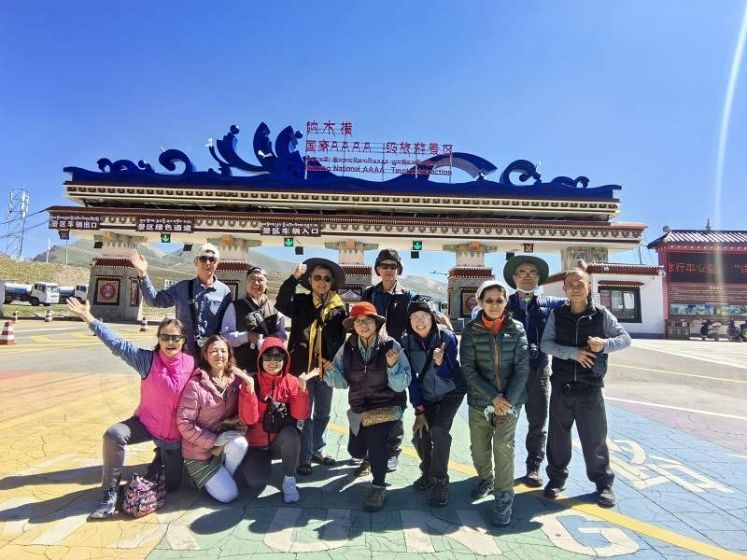
Ready to plan your Namtso trip?
If Namtso’s bright lake, endless skies and spiritual atmosphere are calling you, professional local help will make the trip safer and more rewarding. China Dragon Travel organises tailored day trips, overnight lakeside stays and multi-day trekking options to Namtso, with experienced Tibetan guides who handle permits, tickets and on-site logistics. Whether you want a photography-focused overnight, a gentle cultural visit to Tashi Dor, or a longer kora and trekking experience, they can build an itinerary that matches your fitness, time and interests — and keep you safe on the high plateau.
If you’d like, I can draft a sample booking itinerary based on your travel dates, fitness level and photographic interests — just tell me your arrival date in Lhasa and preferred pace, and I’ll create a ready-to-send suggested plan.



